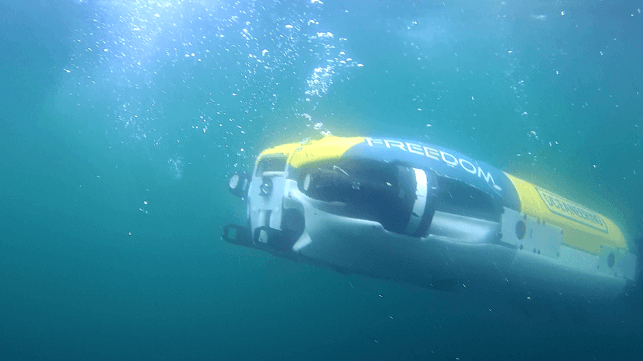U.S. Navy Taps Oceaneering to Deliver Drone Sub for Subsea Monitoring

Texas-based offshore technology company Oceaneering has won a contract to supply one of its Freedom autonomous drone subs to the U.S. Navy, along with an onshore remote operations center for AUV control. The award is the latest example of the Navy's push to bring commercial autonomous technology into frontline service, quickly and at scale.
Freedom was originally designed to fulfill the needs of Oceaneering's offshore oil and gas client base. It is resident-capable, meaning that it can be permanently installed at a subsea docking station, ready to deploy on site as needed. It is also designed to deploy from a support vessel using an over-the-side cage recovery system, which it can maneuver into and lock onto on its own. This system is designed to accommodate harsher operating conditions, which can make launch and recovery operations challenging for larger vehicles.
Freedom was tailored for subsea pipeline inspection at close proximity, operating just 3-5 meters off the seabed. The design objective was to produce an AUV that could fully survey a pipeline in a single pass, without the need to circle back to capture all details. This capability turns out to be suitable for subsea infrastructure monitoring and protection too, according to Oceaneering.
"This award allows us to deliver commercial technology driven by energy industry needs to the U.S. Department of Defense to address subsea security needs," said Peter Buchanan, the head of Oceaneering's subsea robotics division.
The Navy's decision to pick a large commercial subsea-robotics contractor comes with cost and performance advantages, said Oceaneering SVP Martin McDonald. The company has the world's biggest fleet of work class ROVs and manages to maintain a 99 percent uptime rate for these maintenance-intensive assets. It also has nine years and 120,000 operating hours of remote operations center ROV control experience. I
"Oceaneering is able to leverage our existing facilities and supply chain to manufacture vehicles at scale, as we have done and continue to do for the energy industry," he said.
The Navy's manpower, budget and shipbuilding constraints have motivated it to pursue unmanned technology at scale. In hopes of matching China's quantitative dominance in the Western Pacific, the service is pushing for rapid adoption of commercial off the shelf solutions, adopting new contracting methods to access cutting-edge technology. Its "Project Replicator" initiative envisions "multiple thousands" of smaller autonomous systems on land, in the air, on the surface and below the sea, all built cheaply enough to be lost in combat, all delivered by 2025.
"Replicator will galvanize progress in the too-slow shift of US military innovation to leverage platforms that are small, smart, cheap, and many," Deputy Secretary of Defense Kathleen Hicks said last year. "So now is the time to take all-domain, attritable autonomy to the next level: to produce and deliver capabilities to warfighters at the volume and velocity required to deter aggression, to win if we’re forced to fight."
